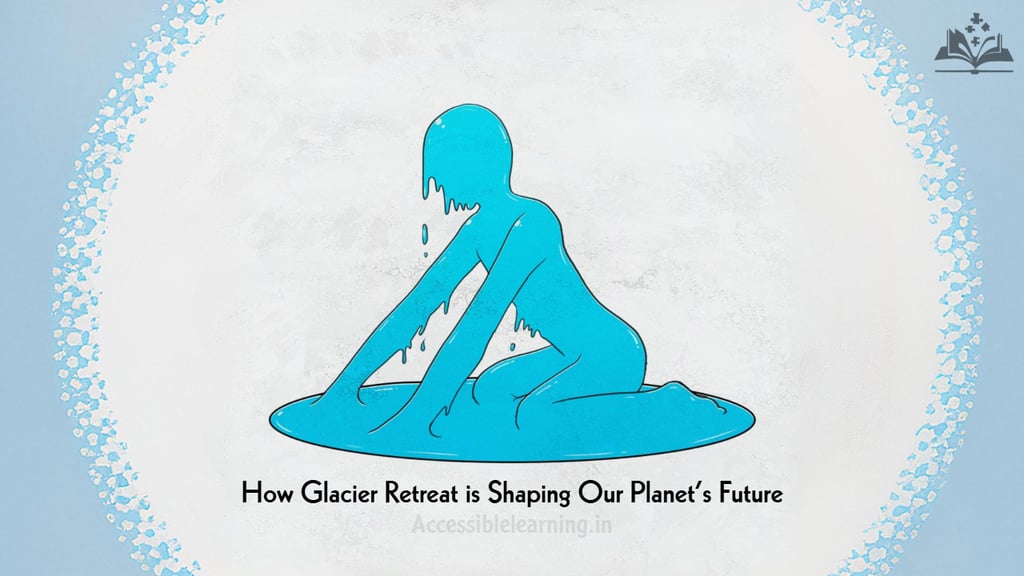
Vanishing Glaciers: A Wake-Up Call for Humanity
Discover the profound impact of glacier contraction on our planet. Learn about the causes, consequences, and solutions to this global crisis as we explore the significance of melting glaciers and the urgent need for action to protect these natural giants.
ENVIRONMENTGLOBAL ISSUESAWARE/VIGILANTA LEARNING
Kim Shin
12/17/20246 min read


The sight of towering glaciers, shimmering in pristine beauty, has inspired awe for millennia. These icy giants not only shape the landscape but also play a pivotal role in maintaining the Earth's delicate ecological balance. However, the alarming contraction of glaciers worldwide signals a pressing environmental crisis with far-reaching consequences. This article delves into the causes, impacts, and urgent need for global action to address glacier retreat.
The Role of Glaciers in Earth's Ecosystem!
Glaciers are not just frozen rivers of ice; they are the lifelines of our planet. Covering about 10% of Earth's surface, these ice masses store nearly 69% of the world’s freshwater. They regulate water cycles, supply freshwater to billions, and act as vital cooling agents by reflecting solar radiation. Additionally, glaciers influence ocean currents and support biodiversity in alpine and polar ecosystems.
Their sheer existence symbolizes Earth's climatic equilibrium. However, human activities have disrupted this balance, putting glaciers in retreat.
The causes of Glacier Contraction!
Global Warming
The primary driver of glacier retreat is the increase in global temperatures due to greenhouse gas emissions. Over the past century, the average global temperature has risen by approximately 1°C, with polar regions warming even faster. This leads to accelerated melting and reduced snowfall, crucial for glacier regeneration.
Black Carbon Deposition
Soot and industrial pollutants settle on glaciers, darkening their surface. This reduces their albedo (reflectivity), causing them to absorb more sunlight and melt faster.
Unsustainable Development
Infrastructure projects, mining, and deforestation in glacier-fed regions exacerbate ice loss by destabilizing surrounding ecosystems.
Ocean Warming
For marine-terminating glaciers, warmer ocean currents erode glacier fronts from beneath, hastening their collapse.
Consequences of Glacier Retreat
Rising Sea Levels
Melting glaciers contribute significantly to sea-level rise, threatening coastal communities and low-lying nations. Since 1900, global sea levels have risen by over 20 centimeters, with melting glaciers being a major contributor.
Water Scarcity
Millions of people rely on glacier-fed rivers for drinking water, agriculture, and hydropower. As glaciers shrink, these rivers face seasonal variability, leading to water shortages.
Disrupted Ecosystems
Glacial retreat affects the flora and fauna adapted to cold climates. Species like snow leopards, polar bears, and certain cold-water fish face habitat loss, pushing them toward extinction.
Increased Natural Disasters
Melting glaciers destabilize mountain slopes, leading to landslides and glacial lake outburst floods (GLOFs). These events can have catastrophic consequences for downstream communities.
Global Climate Feedback Loops
As glaciers melt, darker land and ocean surfaces are exposed, absorbing more heat and accelerating global warming—a vicious cycle known as the albedo effect.

Notable Examples of Glacier Contraction!
Greenland Ice Sheet
The Greenland Ice Sheet is losing ice at an alarming rate, contributing significantly to sea-level rise. Recent studies suggest it could reach a tipping point, leading to irreversible melting.
Himalayan Glaciers
Often referred to as the "Third Pole," the Himalayan glaciers provide water to over a billion people. However, they are retreating rapidly, threatening water security across South Asia.
Antarctica
West Antarctica’s Thwaites Glacier, nicknamed the "Doomsday Glacier," is melting at an unprecedented rate due to warming ocean waters, posing a global threat.
Global Efforts to Combat Glacier Retreat!
International Climate Agreements
Agreements like the Paris Accord aim to limit global temperature rise to below 2°C, which is critical for slowing glacier loss.
Carbon Emission Reductions
Transitioning to renewable energy, improving energy efficiency, and reducing deforestation are key to cutting carbon emissions.
Research and Monitoring
Organizations like NASA and the World Glacier Monitoring Service (WGMS) track glacier changes, providing crucial data for climate models and policy-making.
Community Adaptation
Local communities in glacier-dependent regions are adopting sustainable practices like water conservation and glacier tourism to minimize impact.

Unique Perspectives on Glacier Melting?
Cultural and Historical Significance
Glaciers hold immense cultural and historical value. Indigenous communities, such as the Sherpas in the Himalayas and the Sámi in Scandinavia, view glaciers as sacred and central to their heritage. The disappearance of these ice masses threatens their traditions, folklore, and way of life. In some regions, the receding ice has uncovered ancient artifacts and ecosystems, offering invaluable insights into Earth’s history.
Economic Impacts
Tourism Decline: Glacier tourism generates billions annually for countries like Switzerland, Iceland, and Nepal. As glaciers retreat, landscapes transform, potentially reducing tourist appeal.
Agriculture and Energy: Glacier-fed rivers irrigate farmland and power hydropower stations. Variability in water flow disrupts crop cycles and energy production, directly impacting livelihoods and economies.
Glaciers as Climate Archives
Glaciers preserve atmospheric data in their ice layers, often dating back tens of thousands of years. These natural archives provide scientists with insights into Earth’s past climates. As glaciers melt, we lose this irreplaceable record of ancient atmospheric conditions, making it harder to understand long-term climate trends.
Emerging Trends and Innovations in Glacier Preservation!
Artificial Glacier Creation
In regions like Ladakh, India, locals have innovated "ice stupas," artificial glaciers created to store water during winters and release it during the growing season. This low-tech solution helps counter the effects of glacier retreat.
Geoengineering Proposals
Scientists are exploring geoengineering techniques such as reflective blankets over glaciers to slow melting or pumping cold water beneath ice sheets to stabilize them. While promising, these ideas come with ethical and logistical challenges.
Cryosphere Conservation Advocacy
International organizations, including the United Nations and the International Cryosphere Climate Initiative, are lobbying for stronger glacier protection policies. They emphasize the interdependence of glaciers, oceans, and human well-being.
Unforeseen Environmental Impacts
Release of Ancient Pathogens
Melting glaciers could expose long-frozen pathogens, potentially unleashing ancient viruses and bacteria that modern ecosystems—and human immune systems—are unprepared to handle. This presents a unique biosecurity challenge.
Impact on Global Ocean Currents
Glacial meltwater dilutes saltwater in the oceans, weakening thermohaline circulation, such as the Atlantic Meridional Overturning Circulation (AMOC). This could disrupt global weather patterns, leading to more extreme storms, prolonged droughts, and regional cooling in places like Europe.
Soil Erosion and Loss of Fertility
The retreat of glaciers exposes fragile soils previously shielded by ice. These soils, lacking protective vegetation, are prone to erosion, further destabilizing mountain ecosystems and reducing land fertility.

Regional Highlights of Glacier Melting!
Alaska and the Arctic
Arctic glaciers are some of the fastest-melting on Earth. Alaska’s Columbia Glacier, for instance, has retreated over 20 kilometers since the 1980s. This rapid melt threatens native wildlife, including seals and walruses, and intensifies geopolitical tensions as nations vie for newly accessible Arctic resources.
The Andes and South America
Tropical glaciers in Peru, Bolivia, and Ecuador are retreating at alarming rates. Communities that rely on glacier-fed rivers for farming and drinking water face acute shortages, with some already migrating to urban areas.
The Alps in Europe
Iconic glaciers in the European Alps, such as the Aletsch Glacier, are shrinking rapidly due to rising temperatures. This affects skiing resorts and nearby communities reliant on glacial runoff for water supplies.
Unintended Consequences of Glacier Retreat
Discoveries Beneath the Ice
In 2019, the thawing of Swiss glaciers uncovered the remains of a couple missing since 1942.
In Antarctica, scientists have discovered hidden ecosystems under ice sheets, including microorganisms that thrive in extreme conditions.
While fascinating, these discoveries underline the rapidity of glacier contraction.
Methane Release
Melting permafrost and subglacial sediments can release trapped methane, a potent greenhouse gas, accelerating global warming.
Impact on Indigenous Communities
In regions like Alaska and Siberia, indigenous populations face cultural and economic displacement as ecosystems collapse due to glacier melting. Many traditional practices tied to hunting, fishing, and spirituality are becoming unsustainable.


What You Can Do to Help?
Raise Awareness
Educate others about glacier retreat and its implications. Support campaigns advocating for reduced carbon emissions and stricter environmental regulations.
Support Conservation Efforts
Donate to organizations working on cryosphere conservation, like WWF's Arctic Program or local glacier preservation initiatives.
Reduce Personal Impact
Adopt sustainable practices like reducing energy consumption, using public transport, and minimizing waste.
Switch to renewable energy sources and support companies with sustainable policies.
Engage Politically
Advocate for climate-friendly policies and vote for leaders committed to combating climate change.
The Road Ahead: A Call for Collective Action?
The melting of glaciers is not just a regional issue—it’s a global emergency. Their retreat is a visible indicator of climate change, warning us of the urgent need for systemic change. Governments, industries, and individuals must act collectively to combat the root causes of glacier contraction.
For policymakers: Implement stricter environmental regulations and invest in green infrastructure.
For industries: Shift toward sustainable production and invest in carbon-neutral technologies.
For individuals: Reduce your carbon footprint by adopting eco-friendly habits and supporting conservation initiatives.


The shrinking of glaciers, once thought of as a distant issue, is now an undeniable reality impacting every corner of the globe. These ancient ice formations are more than majestic sights—they are critical to our planet's health. Protecting them means safeguarding our future.
As stewards of the Earth, it is our responsibility to honor the glaciers' silent legacy by preserving them for generations to come. Time is of the essence. Will we act before the giants disappear forever?
Subscribe to our newsletter
All © Copyright reserved by Accessible-Learning
| Terms & Conditions
Knowledge is power. Learn with Us. 📚


